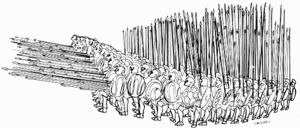Pike (weapon)
- This article is about the weapon. For the fish, see Pike.
A pike is a kind of polearm. It is a very long heavy thrusting spear formerly used by infantry. A pike is not intended to be thrown. Pikes were used regularly in European warfare starting in the early Middle Ages.[1] Until around 1700 pikes were used by foot soldiers in close order formations.

The pike was a long weapon that got longer over time. It could be as long as 20 feet (6 m).[2] It had a wooden shaft with an iron or steel spearhead. It had metal along the sides for three feet (1m) behind the tip so it would not be cut off by a sword or axe.[2]
When many pikes were used together they allowed for a great concentration of spearheads an enemy would have great difficulty getting through. The length also kept the soldier at a greater distance from the enemy. But the length also made pikes difficult to use in close combat. Pikemen were usually arranged in a very tight formation several lines deep. The earliest of these were called a phalanx formation. It was used by the Macedonians under Philip II of Macedon.[3] It was used by the armies of the Pharoahs in ancient Egypt. It was later used by the Swiss pike columns but this formation was probably based on the Scottish Schildrons.[3] The armies of William Wallace and Robert the Bruce used it to great success against the heavy cavalry of kings Edward I of England and his son Edward II of England.[3]
References
change- ↑ J.F. Verbruggen, The Art of Warfare in the Western Europe during the Middle Ages, trans. S. Willard; RW Southern (Woodbridge: Boydell Press, 1997 ), p. 151
- ↑ 2.0 2.1 Trevor Nevitt Dupuy, The Evolution of Weapons and Warfare (New York: Da Capo Press, 1990). p. 85
- ↑ 3.0 3.1 3.2 R. Ewart Oakeshott, European Weapons and Armour : from the Renaissance to the Industrial Revolution (Woodbridge; Rochester, NY: Boydell, 2012), p. 44